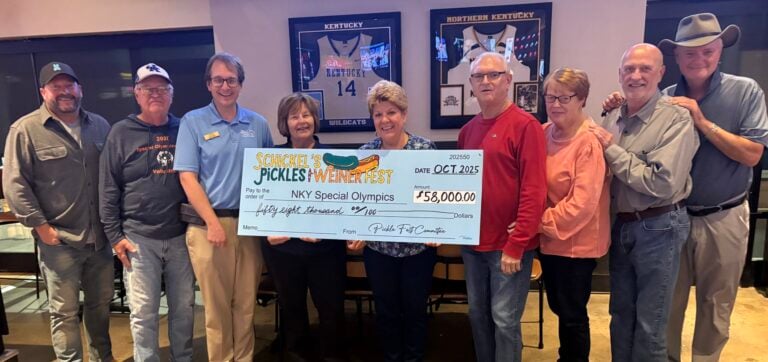By Steve Flairty
NKyTribune columnist
When John Hoffert and his wife, Kim, left Roanoke, Virginia, and located back to their native Northern Kentucky area in 2011, they looked to buy a house within a 15-minute commute of John’s new job in Cincinnati. The prospect of finding an older home with character, then rehabbing it, sounded awfully good to them. Besides, they had a good experience while doing so once before.
After looking for five months, the grandparents of four discovered a place they liked in Highland Heights. They bought it, but at the time, they didn’t know its history, except that it was over a hundred-years-old and, according to John, it had “many opportunities for preserving.” And that’s exactly what the Hofferts began to do with their prized possession.
“We spent several thousand dollars getting the home safe,” John, a recently elected Highland Heights councilman, said, “(while) upgrading electric and plumbing and fireplaces and removing asbestos, as well updating the kitchen. Otherwise, the house looked good cosmetically with original, beautiful hardwood floors, windows, woodwork and chandeliers.”

But, oh, the history surrounding the Hoffert house, as the two later learned and embraced, is quite remarkable.
After poring over some information (drawn from sources cited at the bottom of this article) sent to me by the Hofferts, I learned that the house was the home of E.O Robinson and his wife, Lydia, from 1909 until his death in 1934 and hers in 1951. At that time, according to sources, the address was actually “Cold Spring” rather than Highland Heights, and the Robinson property consisted of 500 acres.
Robinson became very rich in the lumber business in eastern Kentucky. He, along with friend Frederick Mowbray, started buying land there and lumbering it. Their first mill was at Irvine, in 1905. After building a mill in 1908 near Jackson in a community called Quicksand, the partners incorporated the company and it became the Mowbray-Robinson Lumber Company.
The mill became so productive that at one time it employed over 1,000 people and the population grew to 5,000 (not sustained for today). The company operated for about 20 years in the early part of the 20th Century, and it reportedly produced more than 30 million feet of lumber annually.
With the success of the company, Robinson gained great wealth, though in time the trees were largely harvested. He desired to give back a strong portion of the wealth to the people of the region. The company sold most of the land, but he held onto 15,000 acres.
That sizeable parcel became known as Robinson Forest. In 1922, he donated the 15,000 acres to the University of Kentucky and also funded the E.O. Robinson Mountain Fund with a $1 million donation. It was stipulated that the acreage be used as a research and training center for the region. In time, the E.O. Mountain Fund sponsored Robinson scholarships for Berea College and later other colleges.
Edward Purcell reported that in 1951-88, over $7 million was given out in scholarships, grants to hospitals, schools, and other programs in Kentucky.
Today, John and Kim’s 5,000 square-feet home, formerly owned by an amazing Kentuckian who was a strong force in the state’s mountain economy before coal reached its zenith, sits proudly on two nicely landscaped acres. They plan to stay there as long as they can physically take care of the property. Being there invigorates them.
A while back, while Kim worked out in the yard, a couple of senior citizen women stopped by and introduced themselves.
“One told my wife that her great-aunt was Mrs. Robinson. She knew all about the house and gave us two gold-leaf place settings belonging to the original owner, saying ‘These need to be in the house,’” said John.
The two visitors were invited in and many remembrances were shared about the Robinsons and the history of the house. The excitement the meeting engendered further spurred the Hofferts’ interest in finding out about the work of Robinson and his family’s personal abode.
The couple has walked part of the Robinson Forest. They’ve checked out deeds on the house, reviewed census records, and now are attempting to get their home on the National Historical Register. That’s a bit of a process, but don’t be surprised if it happens. Passion can do wonders.
To honor Robinson, along with satisfying their inclination to preserve, the Hofferts are also creating a committee called Save Robinson Forest. Besides working to save a natural habitat for future generations, they hope more people will learn about the northern Kentucky businessman and philanthropist named E.O. Robinson.
“The money he put in the foundation he started is still flowing today,” said John. But in some respects, he noted, “Robinson is an unknown quantity.”
If John and Kim Hoffert have anything to do about it, that will change. They are reminded of the mark he left every day.
Sources: The Value of the Commonwealth: An Ecocritical History of Robinson Forest-David Barrett Gough, University of Iowa Research Online; The Embattled Wilderness: The Natural and Human History of Robinson Forest-Erik Reece and James J. Krupa; Good Neighbor to the Mountains: The Story of the E.O. Robinson Mountain Fund-L. Edward Purcell.
Steve Flairty is a teacher, public speaker and an author of six books: a biography of former Kentucky Afield host Tim Farmer and five in the Kentucky’s Everyday Heroes series, including a kids’ version. Steve’s “Kentucky’s Everyday Heroes #4,” was released in 2015. Steve is a senior correspondent for Kentucky Monthly, a weekly NKyTribune columnist and a member of the Kentucky Humanities Council Speakers Bureau. Contact him at sflairty2001@yahoo.com or visit his Facebook page, “Kentucky in Common: Word Sketches in Tribute.” (Steve’s photo by Connie McDonald)






















